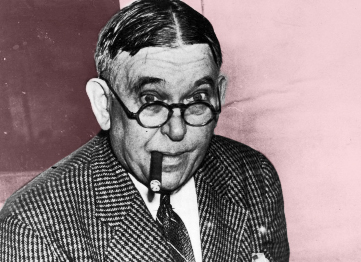
H. L. Mencken and Philip Goodman became close friends while growing up in the German-American neighborhood of West Baltimore. In 1918, Goodman (now a New York bon vivant loosely associated with the publishing industry) sent Mencken a letter paying tribute to their childhood in the 1880s and 1890s, replete with extravagant tall tales featuring their past neighbors. In the letter below, Mencken, then working on The American Language, rises to the challenge, rendering their mutual memories even more ridiculous—and Goodman responded shortly thereafter. The two would try to out-do each other in this type of exchange over the course of the next three years.
February 4th [1918]
Dear Goodman,
That Elias Pfaelzer is still alive fills me with astonishment. It was always my impression that he had died of exposure following old Anton Gegner, president of the Goethe and Schiller Permanent Building and Loan Association, in 1903. This funeral took place on March 1, the day of the blizzard, and the ceremony last three and a half hours. By the time the pallbearers of Carl Schurz Lodge, No. 39, A.F. & A.M. reached Adam Dietrich’s place on their way home, five of them were in a state of collapse. Luckily enough, young Dr. Fritz Spangenberg happened to be in the barroom when they arrived, refreshing himself after a difficult buttock delivery in the neighborhood, and he at once administered stimulants. Three of the old men, however, had to remain at Adam’s overnight. Pap Pfaelzer was one of them, and I always thought that he took pneumonia and died soon after. Perhaps I confused him with old Horst Plumacher, for many years secretary of the Kriegerbund.
News: Young Teenie Langenfelter is engaged to be married to Otto, the oldest boy of Adele Eisenbradt, geb, Kraus. I think you knew Adele back in the eighties. She was the Kraus girl who played the harp.
Mencken
Dear Mencken,
Kraus? Kraus? I knew no Krauses . . . Can it be that you mean the Krausmeyers who kept the Hand Laundry on East Baltimore Street a block away from where the Zinkhands lived? They had a son—a boy of beautiful muscle—who used to demonstrate the Whitely Excerciser in a drug store window on Calvert Street. In the summer, he sold score cards at Oriole Park. But I recollect no daughter.
You did not say if you know the story of the fight between Buchsbaum and Gundelfinger. If you don’t, there’s no use retelling it. And if you do, it’s like that you, in your goyish prejudice, side with Buchsbaum.
Goodman
From The Whimsical Letters of H.L. Mencken and Philip Goodman. Edited by Jack Sanders. Baltimore: Maryland Historical Society, 1996.
FURTHER READING
Mencken’s childhood home was later converted into a museum. Information about his home, and his life, are available on the website of the Mencken House.
The New York Times published an article about the Mencken House, which can be found here.


